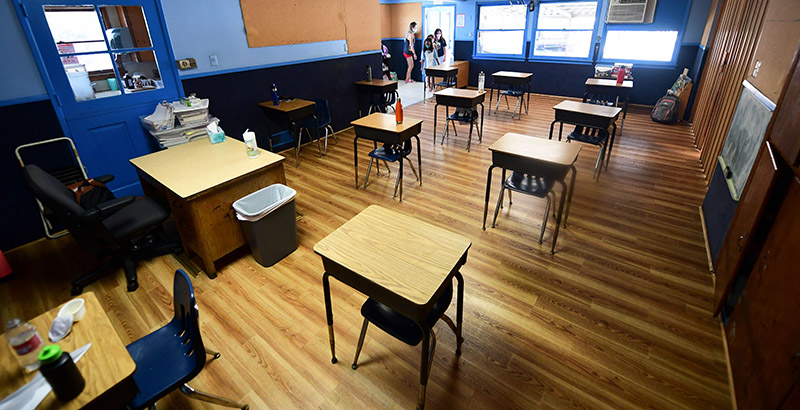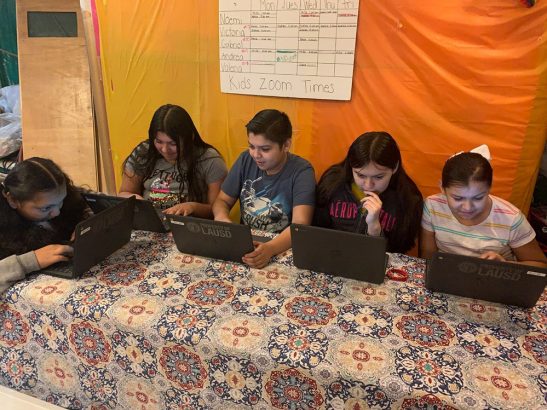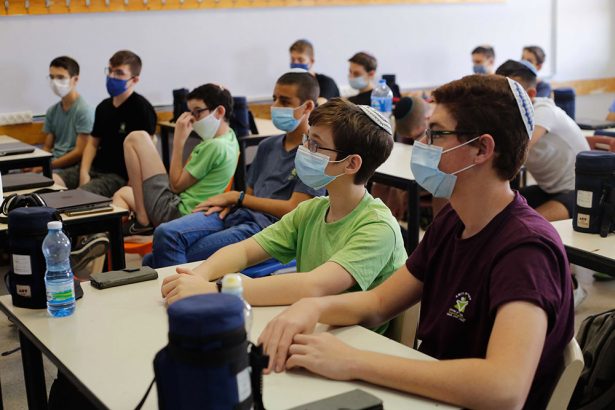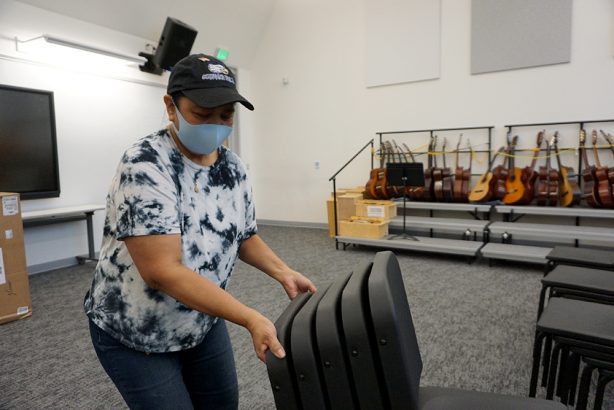‘We Are Being Asked to Do the Impossible’: As Pandemic Spikes in Several States, Parents Brace for Historically Chaotic Return to School

This article was published in partnership with Newsweek.
Back in April, when New York and New Jersey were blowing up like Sodom and Gomorrah, California Gov. Gavin Newsom was golden. Despite its being one of the first states to record cases of COVID-19, California’s outbreak seemed to be well under control. Newsom was optimistic enough to announce a phased reopening that included sending kids back to school in July. “We recognize there’s been a learning loss because of this disruption,” he said at a news briefing, reported by the Los Angeles Times. “You can either, you know, roll over and just accept that or you can do something about it.”
July is here, and the coronavirus clearly has other plans, not just for California but also for the nation. With COVID-19 cases soaring, the Los Angeles Unified School District, the nation’s second largest, will not be opening its doors to its roughly 600,000 students in the fall. Neither will school districts in San Diego and Atlanta. As teachers and their unions fret over safety and forlorn administrators rummage for viable reopening plans, it’s looking increasingly as if many of the nation’s school districts will go the same way.
Parents, teachers and superintendents are apparently responding to a different reality than President Trump (“SCHOOLS MUST OPEN IN THE FALL!!!”) or Education Secretary Betsy DeVos, who has threatened to withhold federal funds from districts that remain shuttered. “There is no way in this world that it’s going to be safe to go back to school,” says Adriana Ruiz, a mother of five in Cudahy, California. “I worked so hard these past few months to keep them safe from this virus, and I’m expected to send them back?”

As new cases of COVID-19 rise at an alarming rate throughout the Sun Belt and states like Texas and Florida that reopened businesses early are considering new lockdowns, school districts are beset by conflicting messages and interests. The odds of a significant number of U.S. schools fully opening in the fall now appear slight, and those that do reopen will probably combine remote learning with limited classroom attendance. Parents, it seems, are going to have to make plans to cope with having the kids at home at least part of the time through the end of the year, and possibly longer.
One of the main arguments for reopening in the fall is that other nations have successfully done it — Trump has cited Norway, Denmark, Germany and Sweden as examples. But with the exception of Sweden, those countries locked down earlier than the U.S., and the prevalence of coronavirus in their populations is far lower. Even so, their schools have not fully reopened — they are still coping with split schedules and instruction in small groups. (Sweden is a special case: Its schools, like the rest of the country, never closed down, and as a result it has had more infections and deaths than its neighbors; there has been little evidence that schools contributed to the outbreak.)
Studies suggest that young children are the least vulnerable to COVID-19 and that classrooms do not constitute large infection risks. But the data are not considered definitive, and the real-world experience so far is mixed. When schools in Denmark, Germany and Austria reopened, the infection rate did not go up, possibly because younger children’s less-developed immune systems don’t allow “the virus to attach as easily,” says Dr. Eva Schernhammer, an epidemiologist at the University of Vienna. But, she says, as long as new cases are climbing, it “may not be advisable” to send children back to school.
Israel’s experience provides a dismal warning of what could happen if schools brush aside advice from public health experts and fully reopen. After the country lifted its lockdown, it opened schools for primary grades into the building and taught the younger students in small groups, or “capsules,” as some experts recommended, while the higher grades worked remotely.
Then, in mid-May, Prime Minister Benjamin Netanyahu ordered all schools to resume normal operations. Two weeks later, outbreaks began increasing. One school had 130 cases, according to scientists who studied reopenings in many countries. Health officials have linked the decision to reopen schools to rising cases across the country. Since June, cases have been climbing, and this week the country began to see some of its worst infection rates since the pandemic began.
Now education officials in the country are making plans to reopen with flexible schedules, according to Rami Benbenishty, a professor emeritus at the Hebrew University of Jerusalem, whose brother is a high school principal. One model being considered is bringing students into the building and allowing teachers to teach from home. “This allows the concentration of technology in school, rather than addressing the needs of a large number of students,” he says.

The best-supported argument for opening schools concerns the lower grades — from kindergarten to second grade — as well as students learning English and those with special needs. These children have lost the most since March and are least likely to thrive in a virtual classroom. Districts are already facing lawsuits because they haven’t been able to provide all the services for special needs students that were agreed to with families before school closures. “Those are recommendations that science would support us making,” said Philip Fisher, a psychology professor at the University of Oregon, who conducts a weekly survey of the pandemic’s impact on families with young children. “Groups facing the greatest inequalities need the support more. It’s justifiable, whether people like it or not.”
There’s no consensus among experts that opening for these kids would be safe. In South Korea, which has a lower level of coronavirus in circulation than the U.S. does, elementary school students attend school only once a week because officials decided they were the least likely to social distance and attend to personal hygiene.
So far in the U.S., only rural districts in mountain states such as Idaho, Wyoming and Montana have reopened during the pandemic. But the lessons they offer for the rest of the country are likely meager. In Montana, the 12 districts that fully reopened on May 7 each have fewer than 50 students, which makes maintaining the recommended distance between them less of a challenge than it does for bigger urban schools.
Schools will likely follow a hodgepodge of policies in the fall. In Florida, despite rising infections, the education commissioner joined the president in ordering schools to reopen with students in classrooms. School boards across Arizona, a COVID-19 hot spot, are petitioning the governor to delay opening until October; one district in Phoenix has gone ahead and announced that it was going to hold off for a few months. And New York City schools, the nation’s largest, will proceed with a blended model in which roughly half the normal number of students will be allowed in the buildings while the rest stay at home.
Having many children learning from home will place a burden on parents and on the economy. Working parents comprise about one-third of the American workforce. Until they can fully resume the work schedules they had before schools and child care programs shut down, it will be difficult to jump-start the economy, according to Nicole Bateman with the Brookings Institution. There have also been signs that in two-parent homes, working mothers have been working fewer hours while the fathers continue working full time, further contributing to loss of income. Although the unemployment rate has bounced back slightly since May, school closures could bring it back up again.
Families have grown increasingly concerned over evictions and whether they can afford basic necessities. Data released Tuesday from Parents Together, a 2 million-member parent organization, shows that 45 percent of families are somewhat or very concerned about losing their home, and more than half said they were only able to cover their rent or mortgage in April because they cut back on other essentials.
Whatever districts decide to do, school leaders are caught in a bind. “We are being asked to do the impossible,” said Susan Enfield, superintendent of the Highline Public Schools, a 19,600-student district south of Seattle. “I have an enormous square peg that I’m trying to squeeze into a microscopic round hole. There are no great scenarios here.”
For every socially distanced attendance plan her staff develops, they can think of multiple reasons why it wouldn’t work. They initially proposed an approach that put many of the most vulnerable students, including the youngest children, in buildings four days a week. But that runs the risk of “losing young adolescents in droves,” she said. “We believe every one of our kids is going to have to have that in-person contact.”

She wants to start translating some of these models on paper to help “people picture what it could look like” and give teachers time for practicing the new routine in the building.
And then?
“Once we land on the least bad option,” she said. “We have to sell it like nobody’s business for our kids. That third-grader, this is the only year they get to be a third-grader.”
WATCH — A Raging Debate Over Why We Should (and Shouldn’t) Reopen Classrooms
Get stories like these delivered straight to your inbox. Sign up for The 74 Newsletter

;)
